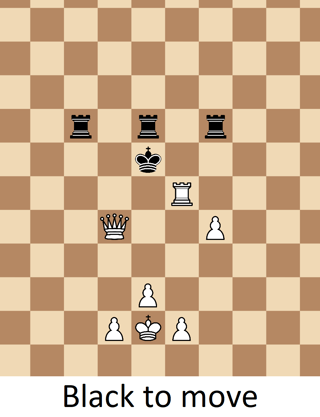Motivation - Long range mating patterns
This question is inspired by my recent interest in infinite chess and the post on MathOverflow Checkmate in ω moves?. Since my chess endgame skills are quite lacking, I am sincerely asking the chess community for help and inspiration. My ultimate goal is to find and collect various kinds of positions with a limited amount of pieces on an infinite chess board that are winning for white but where checkmate can take an arbitrarily long time (We omit the 50-move-rule). I apologize if this question is too vague / open-ended.
There are well-understood positions on chess boards with n×n squares (i.e. we extend the "small" 8×8 board) where the position is winning for white, but the number of moves to checkmate is increasing in n. Let's look at some of them.
Known examples
Consider this example rook vs bishop endgame that we have set up on the bottom left corner of this n×n chess board: (I will paraphrase an explanation by user Noam in the answer to the above-mentioned post.)
White's winning plan is to play something like Rb7, Ra7, and then a waiting move like Ra6 to force Black to play Ka1 when Rxa3 is mate (zugzwang). On the 8×8 board Black can postpone this for only a few moves. For example, if 1...Bd6 then 2.Rb6 and if Black saves the Bishop, then 3.Ra6(+) etc. (best is 2...Ka3 but we know that after capturing the bishop white wins in just a couple of moves on any board size). Black does better with 1...Be7, so after 2.Rb7 Black can play 2...Bc5 to prevent Ra7; but White continues with 3.Rb5 and next move either takes the Bishop or initiates the mating pattern with Ra5. Note that if White went to a "random" spot on the second file Black would escape with Ka3; that's why it's important to move to the row the Bishop is on and threaten it.
On an n×n board the same position is checkmate in around log₂(n) moves, which seems to be the maximum for K+R against K+B. For example, with at least 9 columns and 11 rows, Black could hold on to his Bishop for an extra move by starting 1...Bi11, so that 2.Rb11 can be answered with 2...Be7 holding a11. But then 3.Rb7 reduces to a previously solved problem and white wins as before. To survive one more move than that, Black would have to start by moving the Bishop 16 squares out, to survive two more moves Black would have to move it 32 squares out etc.; in general if Black moves to file n+1 then White checkmates in around log₂(n) moves.
By making the board arbitrarily large the checkmate can be drawn out arbitrarily. However, note that even on a truly infinite chess board with no north and eastern edges, white always wins in some finite amount of moves because black has to commit to a distance with his first bishop move, i.e. he has to make some move. Thus, this is called "checkmate-in-ω" because black can choose any arbitrarily large number of moves to postpone the checkmate.
Three other examples of checkmate-in-ω are pictured here: (I know that the last 2 positions are artificial.)
In all cases, black can postpone the checkmate as long as he wants by moving the rook besides his king as many squares away as he wishes. In the first position of the queen vs rook endgame, White wins after around log₂(n) moves again by repeated checks and an eventual fork - note that the board edges play an indispensable role for the checkmate. In the second position, white wins after chasing the Black king north with his queen and rook for n moves (alternatingly moving his rook and queen up). Here the board edges play no role in the checkmate pattern and I omitted them. In the last position, white will win after moving 3 pawns, after which the bottled-up queens escape and finish black off. After each pawn move, black gets to move his rook arbitrarily far along the second row, threatening mate; white will have to move his king for n moves one step at a time, pursued by black's, until reaching the rook to get a "tempo" for the next pawn move. (Thus, this position is technically even checkmate-in-ω*3 on an infinite board, since black can move his rook away arbitrarily far away 3 times.) Here, the lower board edge is indispensable for the checkmate threat by black.
(Nota bene: There are some extensions of these positions with additional pieces / pawns so that black can choose not only once but several times how many moves are still needed for white. An example for such an ω*2 position, which is an extension of my first example, can be found here. This is welcome, but it is not necessarily the kind of novel mating ideas that I am looking for.)
My Question
Do you know of other examples of (maybe even classic) chess endgame positions with a fixed amount of pieces that can get drawn out arbitrarily long only by extending the board from 8×8 to n×n (and keeping all else constant)? Is there maybe some systematic way of constructing these positions with long-ranged mating nets? Some Q-R and R-B endgames have this feature as I showed in this post; maybe we can also find this feature in various other endgames? (where maybe bishops and knights also play a more important role?) I would like to collect as many examples of such mating nets as possible and, ideally, be able to combine various ideas in the same position, in the end. I am interested both in cases where the board edges play a role and in edgeless boards. I am not so much interested in slight modifications of these positions but in different mating ideas like these and endgames with similar features.




